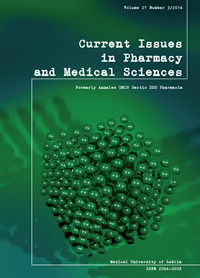Consumption and awareness of students about nonsteroidal anti-inflammatory drugs
DOI:
https://doi.org/10.1515/cipms-2015-0010Keywords:
pain, inflammation, fever, adverse effects, NSAIDsAbstract
Nonsteroidal anti-inflammatory drugs (NSAIDs) are used by millions of people worldwide to neutralize pain that is of different origin, as well as to treat fever and inflammation. However, NSAIDs misuse/overuse can induce many adverse effects and some potentially serious complications. The aim of the our study was to ascertain young people’s knowledge about non-steroidal anti-inflammatory drugs. The research tool was a questionnaire. This study was carried out among students of the Medical University in Lublin, and it involved 236 persons of an average age of 20 years. The questions were intended to assess the frequency of NSAIDs use and the general knowledge that is held with respect to them. The results of this work show that more than 77% of the respondents confirmed that they use NSAIDs. Our results revealed no statistical correlation between the place of living or origin and the use of this drug. Hence, it can be said that while young adults quite often use NSAIDs, their knowledge about the dangers associated with the use of NSAIDs is low. Therefore, it is necessary to more intensively disseminate knowledge on the potential adverse effects of NSAID utilization.
References
1. Adamek E. et al: Photodegradation of the selected anti-inflammatory drugs in the aquatic environment. Proceedings of ECOpole 5(1), 147, 2011.
2. Broniarczyk-Dyła G., Urysiak-Czubatka I.: Cutaneous adverse effects of nonsteroidal anti-inflammatory drugs. Post Dermatol Alergol. XXIV, 6, 247, 2007.
3. Gadomski A.: Nonsteroidal anti-inflammatory drugs in the medicine cabinet. Med Rodzinna, 2, 37, 2006 [In Polish].
4. Gazarian M., Graudins L.V.: Safe use of NSAIDs in infants and children. Medicine Today, 7(11), 71, 2006.
5. Gené E., Calvet X., Morón A., Iglesias M.L.: Recommendations for the use of anti-inflammatory drugs and indications for gastrointestinal protection in emergency departments. Emergencias 21, 295, 2009.
6. Hawton K. et al: Long term effect of reduced pack sizes of paracetamol on poisoning deaths and liver transplant activity in England and Wales: interrupted time series analyses. BMJ, 7,346, 2013:f403. doi: 10.1136/bmj.f403.
7. Hernández-Cortez E.: Non-steroidal Anti-inflammatory Analgesics in Children. Anestesia en México, 18(1), 162, 2006.
8. Kowalski M.L. et al: Hypersensitivity to nonsteroidal antiinflam-matory drugs (NSAIDs) - classification, diagnosis and management: review of the EAACI/ENDA(#) and GA2LEN/HANNA*. Allergy, 66(7), 818, 2011. doi: 10.1111/j.1398-9995.2011.02557.x.
9. Luo X. et al: Prescription of nonsteroidal anti-inflammatory drugs and muscle relaxants for back pain in the United States. Spine, 1,29(23), 2004:E531-E537.
10. Międzybrodzki R.: Kierunki poszukiwań i zastosowanie niesteroidowych leków przeciwzapalnych. Post. Hig. i Med. Dośw., 58, 438, 2004.
11. [Reguła J. et al: Stosowanie niesteroidowych leków przeciwzapalnych w Polsce – badanie ankietowe u 38 tysięcy chorych. Gastroenterologia Kliniczna, 3(2), 72, 2011.
12. Vonkeman H.E., Van De Laar M.A.: Nonsteroidal anti-inflammatory drugs: adverse effects and their prevention. Semin Arthritis Rheum., 39(4), 294, 2010. doi: 10.1016/j.semarthrit.2008.08.001,
13. Wisłowska M.:Przewlekłe stosowanie NLPZ – zagrożenia, potencjalne powikłania. Med Rodzinna, 1, 22, 2004.
Downloads
Published
Issue
Section
License
Copyright (c) 2015 Authors

This work is licensed under a Creative Commons Attribution-NonCommercial-NoDerivatives 3.0 Unported License.


